Abstract
1. The effects of electrical stimulation and microinjections (90 nl) of the 5-HT1A receptor agonists, flesinoxan and 8-hydroxy-2-(di-n-propylamino) tetralin (8-OH-DPAT), and glutamate into the raphe obscurus on blood pressure, heart rate and phrenic nerve activity (central inspiratory drive) were investigated in rats anaesthetized with alpha-chloralose. 2. Electrical stimulation of the raphe obscurus caused a rise in blood pressure which was associated with bradycardia, while glutamate (2.7 nmol) caused only a rise in blood pressure. 3. Flesinoxan (1.3 nmol) and 8-OH-DPAT (0.7 nmol) increased blood pressure by 9 +/- 1 and 14 +/- 2 mmHg, respectively and did not affect heart rate. For both agonists the effect on blood pressure was shown to be dose-dependent; again no effect on the heart rate was observed over the dose-ranges chosen. 4. Microinjections of the non-selective 5-HT1A receptor antagonists, (+/-)-pindolol (2.7 nmol) or methiothepin (5.2 nmol), into the raphe obscurus prevented the increase in blood pressure caused by microinjection of flesinoxan. However, (+/-)-pindolol caused a sustained rise in blood pressure of 15 +/- 1 mmHg while methiothepin caused a transient rise in blood pressure. Neither drugs affected heart rate. The ability of methiothepin to attenuate the pressor effect of flesinoxan was found to be partially reversed after 30 min. 5. It is suggested that activation of 5-HT1A receptors within the raphe obscurus can cause sympatho-excitation.
Full text
PDF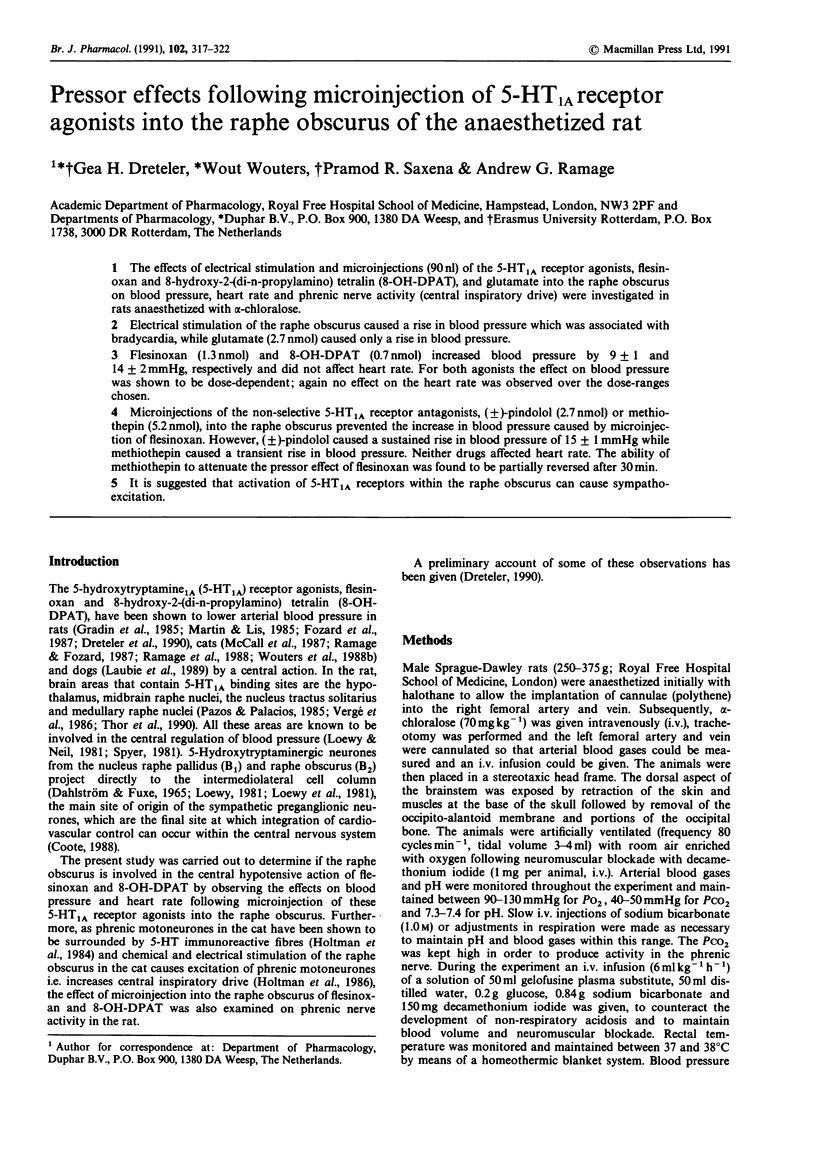
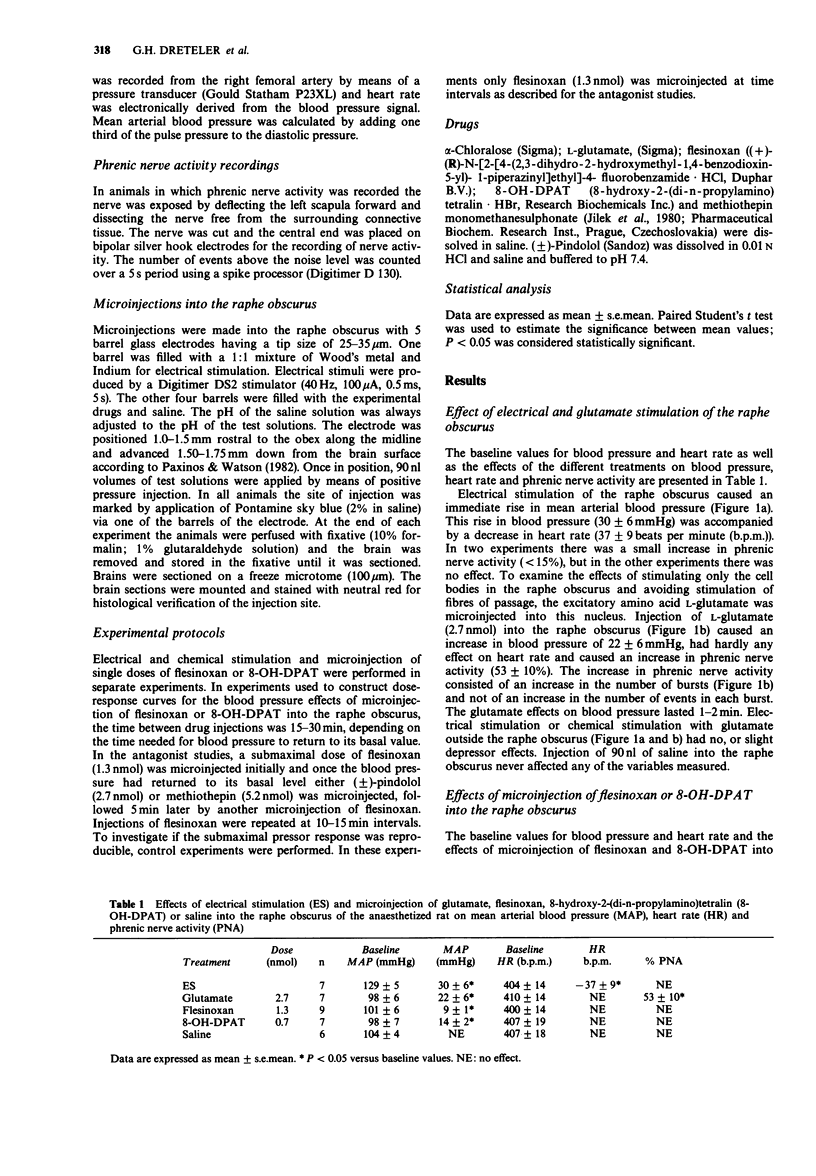
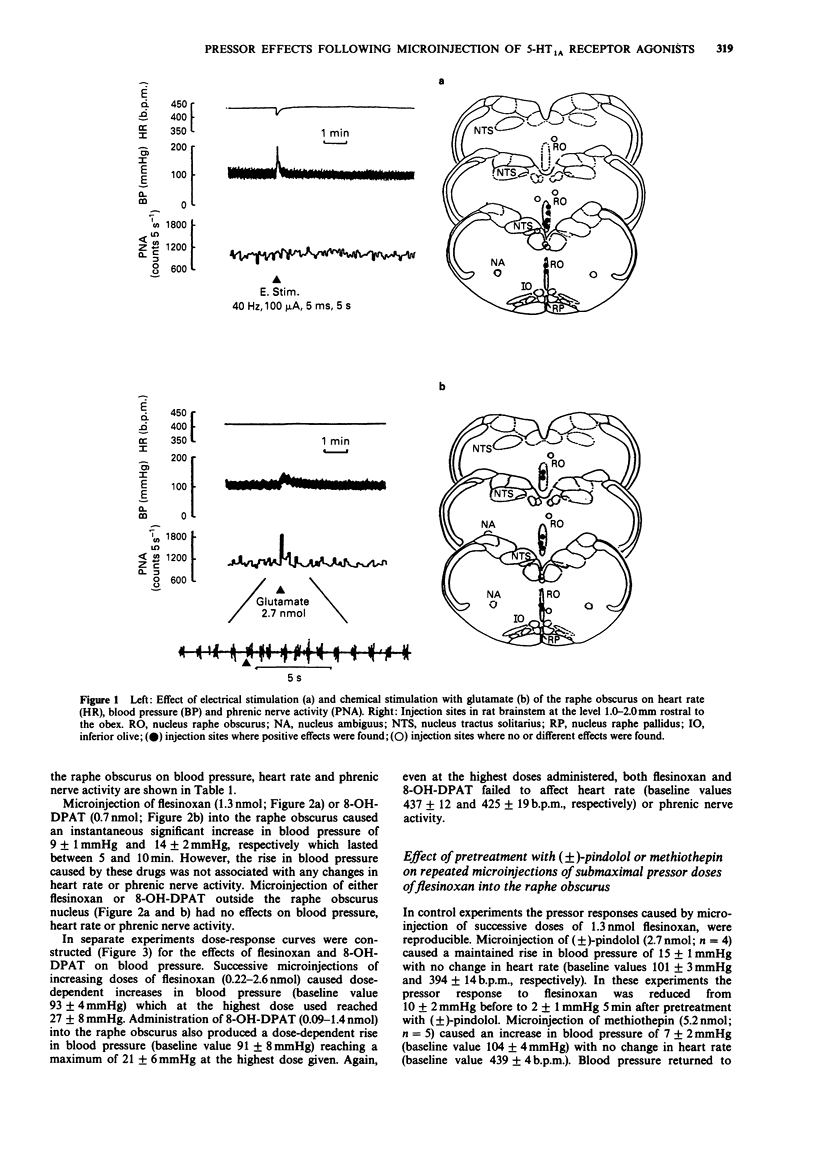
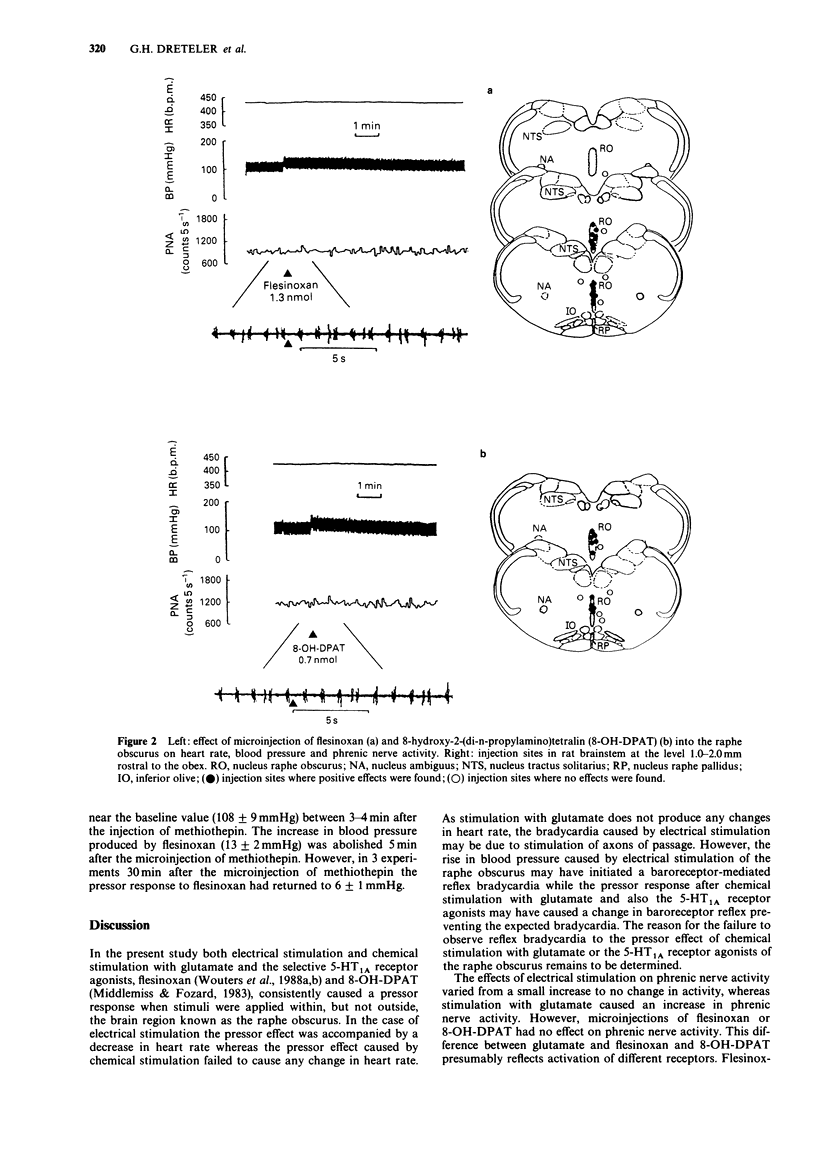
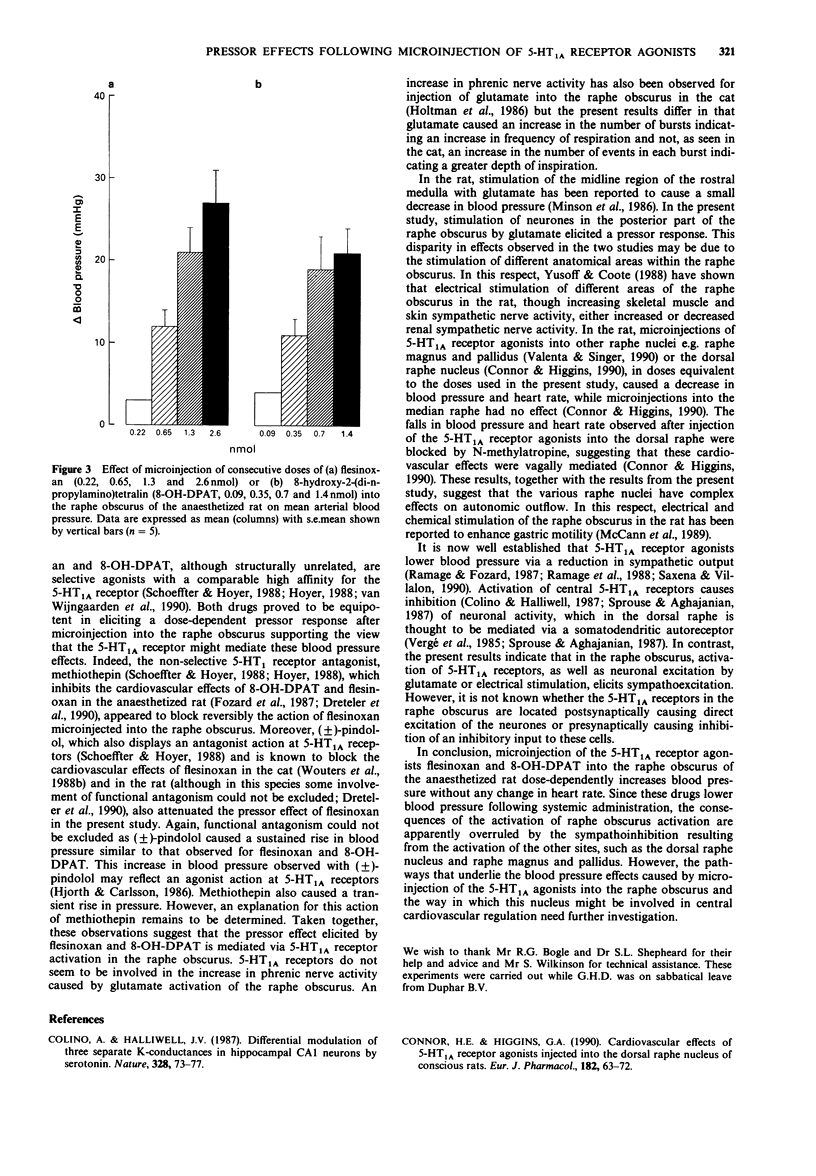
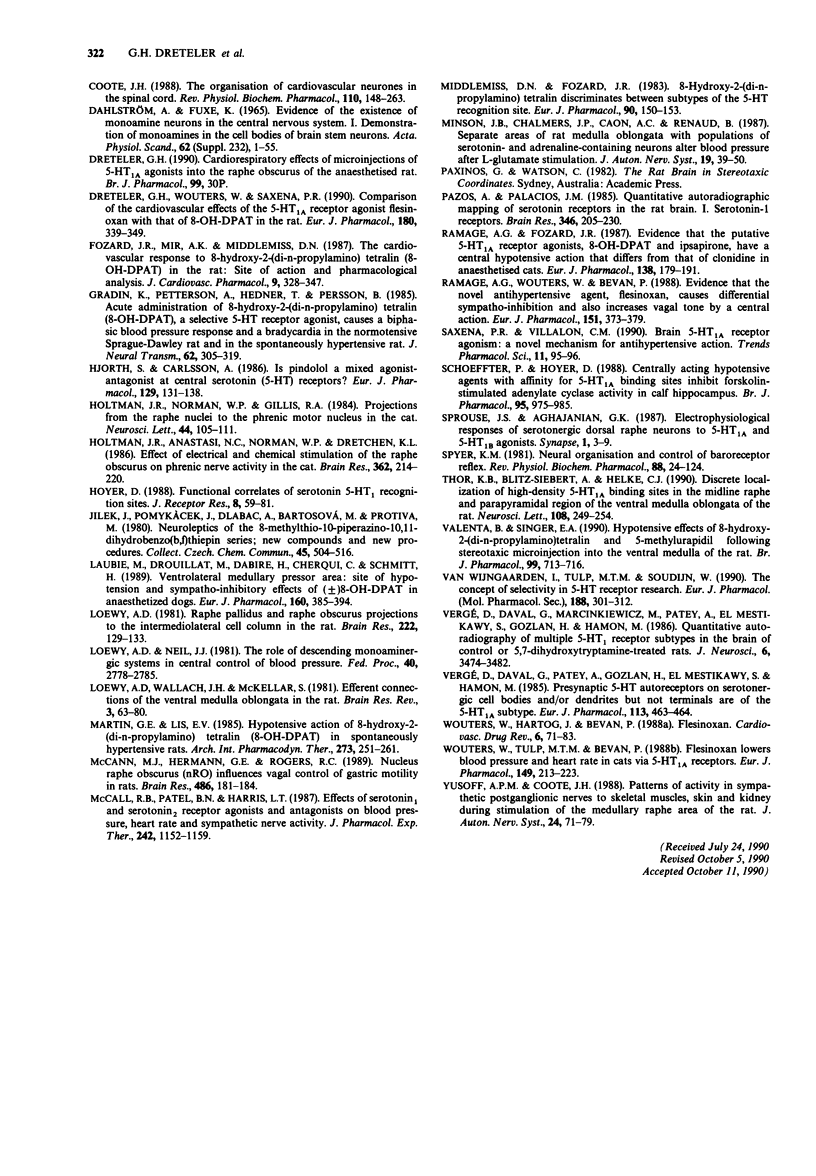
Selected References
These references are in PubMed. This may not be the complete list of references from this article.
- Colino A., Halliwell J. V. Differential modulation of three separate K-conductances in hippocampal CA1 neurons by serotonin. Nature. 1987 Jul 2;328(6125):73–77. doi: 10.1038/328073a0. [DOI] [PubMed] [Google Scholar]
- Connor H. E., Higgins G. A. Cardiovascular effects of 5-HT1A receptor agonists injected into the dorsal raphe nucleus of conscious rats. Eur J Pharmacol. 1990 Jun 21;182(1):63–72. doi: 10.1016/0014-2999(90)90493-p. [DOI] [PubMed] [Google Scholar]
- Dreteler G. H., Wouters W., Saxena P. R. Comparison of the cardiovascular effects of the 5-HT1A receptor agonist flesinoxan with that of 8-OH-DPAT in the rat. Eur J Pharmacol. 1990 May 16;180(2-3):339–349. doi: 10.1016/0014-2999(90)90319-2. [DOI] [PubMed] [Google Scholar]
- Fozard J. R., Mir A. K., Middlemiss D. N. Cardiovascular response to 8-hydroxy-2-(di-n-propylamino) tetralin (8-OH-DPAT) in the rat: site of action and pharmacological analysis. J Cardiovasc Pharmacol. 1987 Mar;9(3):328–347. doi: 10.1097/00005344-198703000-00010. [DOI] [PubMed] [Google Scholar]
- Gradin K., Pettersson A., Hedner T., Persson B. Acute administration of 8-hydroxy-2-(di-n-propylamino)tetralin (8-OH-DPAT), a selective 5-HT-receptor agonist, causes a biphasic blood pressure response and a bradycardia in the normotensive Sprague-Dawley rat and in the spontaneously hypertensive rat. J Neural Transm. 1985;62(3-4):305–319. doi: 10.1007/BF01252244. [DOI] [PubMed] [Google Scholar]
- Hjorth S., Carlsson A. Is pindolol a mixed agonist-antagonist at central serotonin (5-HT) receptors? Eur J Pharmacol. 1986 Sep 23;129(1-2):131–138. doi: 10.1016/0014-2999(86)90344-4. [DOI] [PubMed] [Google Scholar]
- Holtman J. R., Jr, Anastasi N. C., Norman W. P., Dretchen K. L. Effect of electrical and chemical stimulation of the raphe obscurus on phrenic nerve activity in the cat. Brain Res. 1986 Jan 8;362(2):214–220. doi: 10.1016/0006-8993(86)90446-4. [DOI] [PubMed] [Google Scholar]
- Holtman J. R., Jr, Norman W. P., Gillis R. A. Projections from the raphe nuclei to the phrenic motor nucleus in the cat. Neurosci Lett. 1984 Jan 27;44(1):105–111. doi: 10.1016/0304-3940(84)90229-5. [DOI] [PubMed] [Google Scholar]
- Hoyer D. Functional correlates of serotonin 5-HT1 recognition sites. J Recept Res. 1988;8(1-4):59–81. doi: 10.3109/10799898809048978. [DOI] [PubMed] [Google Scholar]
- Laubie M., Drouillat M., Dabiré H., Cherqui C., Schmitt H. Ventrolateral medullary pressor area: site of hypotensive and sympatho-inhibitory effects of (+/-)8-OH-DPAT in anaesthetized dogs. Eur J Pharmacol. 1989 Feb 7;160(3):385–394. doi: 10.1016/0014-2999(89)90094-0. [DOI] [PubMed] [Google Scholar]
- Loewy A. D., Neil J. J. The role of descending monoaminergic systems in central control of blood pressure. Fed Proc. 1981 Nov;40(13):2778–2785. [PubMed] [Google Scholar]
- Loewy A. D. Raphe pallidus and raphe obscurus projections to the intermediolateral cell column in the rat. Brain Res. 1981 Oct 5;222(1):129–133. doi: 10.1016/0006-8993(81)90946-x. [DOI] [PubMed] [Google Scholar]
- Loewy A. D., Wallach J. H., McKellar S. Efferent connections of the ventral medulla oblongata in the rat. Brain Res. 1981 Aug;228(1):63–80. doi: 10.1016/0165-0173(81)90012-6. [DOI] [PubMed] [Google Scholar]
- Martin G. E., Lis E. V., Jr Hypotensive action of 8-hydroxy-2-(di-N-propylamino)tetralin (8-OH-DPAT) in spontaneously hypertensive rats. Arch Int Pharmacodyn Ther. 1985 Feb;273(2):251–261. [PubMed] [Google Scholar]
- McCall R. B., Patel B. N., Harris L. T. Effects of serotonin1 and serotonin2 receptor agonists and antagonists on blood pressure, heart rate and sympathetic nerve activity. J Pharmacol Exp Ther. 1987 Sep;242(3):1152–1159. [PubMed] [Google Scholar]
- McCann M. J., Hermann G. E., Rogers R. C. Nucleus raphe obscurus (nRO) influences vagal control of gastric motility in rats. Brain Res. 1989 May 1;486(1):181–184. doi: 10.1016/0006-8993(89)91292-4. [DOI] [PubMed] [Google Scholar]
- Middlemiss D. N., Fozard J. R. 8-Hydroxy-2-(di-n-propylamino)-tetralin discriminates between subtypes of the 5-HT1 recognition site. Eur J Pharmacol. 1983 May 20;90(1):151–153. doi: 10.1016/0014-2999(83)90230-3. [DOI] [PubMed] [Google Scholar]
- Minson J. B., Chalmers J. P., Caon A. C., Renaud B. Separate areas of rat medulla oblongata with populations of serotonin- and adrenaline-containing neurons alter blood pressure after L-glutamate stimulation. J Auton Nerv Syst. 1987 Apr;19(1):39–50. doi: 10.1016/0165-1838(87)90143-3. [DOI] [PubMed] [Google Scholar]
- Pazos A., Palacios J. M. Quantitative autoradiographic mapping of serotonin receptors in the rat brain. I. Serotonin-1 receptors. Brain Res. 1985 Nov 4;346(2):205–230. doi: 10.1016/0006-8993(85)90856-x. [DOI] [PubMed] [Google Scholar]
- Ramage A. G., Fozard J. R. Evidence that the putative 5-HT1A receptor agonists, 8-OH-DPAT and ipsapirone, have a central hypotensive action that differs from that of clonidine in anaesthetised cats. Eur J Pharmacol. 1987 Jun 19;138(2):179–191. doi: 10.1016/0014-2999(87)90431-6. [DOI] [PubMed] [Google Scholar]
- Ramage A. G., Wouters W., Bevan P. Evidence that the novel antihypertensive agent, flesinoxan, causes differential sympathoinhibition and also increases vagal tone by a central action. Eur J Pharmacol. 1988 Jul 14;151(3):373–379. doi: 10.1016/0014-2999(88)90533-x. [DOI] [PubMed] [Google Scholar]
- Saxena P. R., Villalón C. M. Brain 5-HT1A receptor agonism: a novel mechanism for antihypertensive action. Trends Pharmacol Sci. 1990 Mar;11(3):95–96. doi: 10.1016/0165-6147(90)90187-d. [DOI] [PubMed] [Google Scholar]
- Schoeffter P., Hoyer D. Centrally acting hypotensive agents with affinity for 5-HT1A binding sites inhibit forskolin-stimulated adenylate cyclase activity in calf hippocampus. Br J Pharmacol. 1988 Nov;95(3):975–985. doi: 10.1111/j.1476-5381.1988.tb11728.x. [DOI] [PMC free article] [PubMed] [Google Scholar]
- Sprouse J. S., Aghajanian G. K. Electrophysiological responses of serotoninergic dorsal raphe neurons to 5-HT1A and 5-HT1B agonists. Synapse. 1987;1(1):3–9. doi: 10.1002/syn.890010103. [DOI] [PubMed] [Google Scholar]
- Spyer K. M. Neural organisation and control of the baroreceptor reflex. Rev Physiol Biochem Pharmacol. 1981;88:24–124. [PubMed] [Google Scholar]
- Thor K. B., Blitz-Siebert A., Helke C. J. Discrete localization of high-density 5-HT1A binding sites in the midline raphe and parapyramidal region of the ventral medulla oblongata of the rat. Neurosci Lett. 1990 Jan 22;108(3):249–254. doi: 10.1016/0304-3940(90)90649-t. [DOI] [PubMed] [Google Scholar]
- Valenta B., Singer E. A. Hypotensive effects of 8-hydroxy-2-(di-n-propylamino)tetralin and 5-methylurapidil following stereotaxic microinjection into the ventral medulla of the rat. Br J Pharmacol. 1990 Apr;99(4):713–716. doi: 10.1111/j.1476-5381.1990.tb12994.x. [DOI] [PMC free article] [PubMed] [Google Scholar]
- Verge D., Daval G., Patey A., Gozlan H., el Mestikawy S., Hamon M. Presynaptic 5-HT autoreceptors on serotonergic cell bodies and/or dendrites but not terminals are of the 5-HT1A subtype. Eur J Pharmacol. 1985 Jul 31;113(3):463–464. doi: 10.1016/0014-2999(85)90099-8. [DOI] [PubMed] [Google Scholar]
- Vergé D., Daval G., Marcinkiewicz M., Patey A., el Mestikawy S., Gozlan H., Hamon M. Quantitative autoradiography of multiple 5-HT1 receptor subtypes in the brain of control or 5,7-dihydroxytryptamine-treated rats. J Neurosci. 1986 Dec;6(12):3474–3482. doi: 10.1523/JNEUROSCI.06-12-03474.1986. [DOI] [PMC free article] [PubMed] [Google Scholar]
- Wouters W., Tulp M. T., Bevan P. Flesinoxan lowers blood pressure and heart rate in cats via 5-HT1A receptors. Eur J Pharmacol. 1988 May 10;149(3):213–223. doi: 10.1016/0014-2999(88)90651-6. [DOI] [PubMed] [Google Scholar]
- Yusof A. P., Coote J. H. Patterns of activity in sympathetic postganglionic nerves to skeletal muscle, skin and kidney during stimulation of the medullary raphe area of the rat. J Auton Nerv Syst. 1988 Sep;24(1-2):71–79. doi: 10.1016/0165-1838(88)90137-3. [DOI] [PubMed] [Google Scholar]
- van Wijngaarden I., Tulp M. T., Soudijn W. The concept of selectivity in 5-HT receptor research. Eur J Pharmacol. 1990 Jun 12;188(6):301–312. doi: 10.1016/0922-4106(90)90190-9. [DOI] [PubMed] [Google Scholar]


